Coccothrinax
Coccothrinax ist eine in der Karibik heimische Gattung der Palmengewächse.
| Coccothrinax | ||||||||||||
|---|---|---|---|---|---|---|---|---|---|---|---|---|
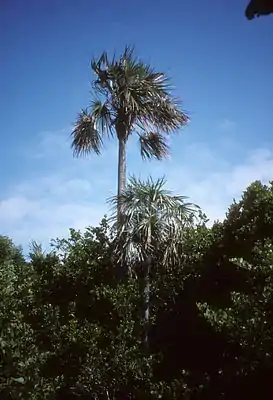
Coccothrinax argentata | ||||||||||||
| Systematik | ||||||||||||
| ||||||||||||
| Wissenschaftlicher Name | ||||||||||||
| Coccothrinax | ||||||||||||
| Sarg. |
Merkmale
Die Vertreter sind kleine bis mittelgroße, einzel- oder mehrstämmige, zwittrige Fächerpalmen. Der Stamm ist schlank und zunächst mit den faserigen Blattscheiden bedeckt, später von einem faserigen Netzwerk oder mit langen schlanken Fasern oder Stacheln. Die Blätter sind fächerförmig, aufsteigend bis abstehend und induplicat (V-förmig) gefaltet.
Der Blütenstand ist kürzer als die Blätter, schlank und zweifach verzweigt. Der Blütenstandsstiel ist kurz und schlank, an ihm stehen ein Vorblatt und mehrere Hochblätter. Die Blüten stehen einzeln. Die Blütenhülle ist einheitlich und sechszähnig. Das Gynoeceum besteht aus einem Fruchtblatt mit einer einzelnen Samenanlage. Es gibt meist 9 (selten 6 bis 13) Staubblätter.
Die Frucht ist braun, pink, rot oder schwarz, nur selten weiß. Das Exokarp ist glatt oder rau, das Mesokarp ist dünn oder etwas fleischig mit Fasern im inneren Bereich. Das Endokarp ist häutig. Der Samen ist tief gefurcht, aber nicht zweilappig.
Die Chromosomenzahl beträgt 2n = 36.
Verbreitung und Standorte
Coccothrinax kommt von Florida nach Süden bis Kolumbien vor. Der Verbreitungsschwerpunkt liegt dabei auf den Westindischen Inseln. Die höchste Diversität erreicht sie auf Kuba mit etwa 37 Arten. Die Gattung findet sich vorwiegend an offenen, trockenen Standorten, in der Regel auf Kalkstein, Serpentin oder Sandstein.
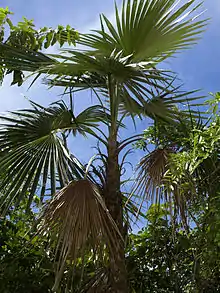
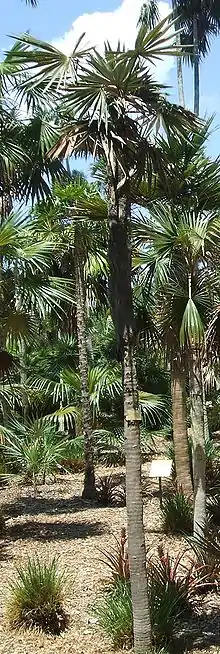
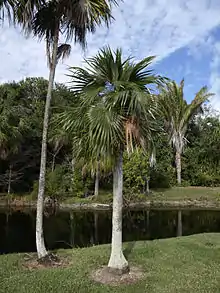
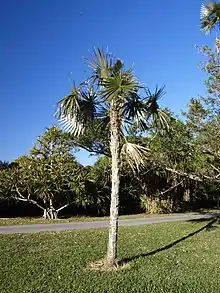
Systematik
Die Gattung Coccothrinax Sarg. wird innerhalb der Familie Arecaceae in die Unterfamilie Coryphoideae, Tribus Cryosophileae gestellt. Der Gattungsname Coccothrinax wurde vom Erstautor nicht erklärt, dürfte sich aber von coccus „Beere“ und dem Gattungsnamen Thrinax ableiten.
Die Gattung ist monophyletisch.[1]
In der World Checklist of Selected Plant Families der Royal Botanic Gardens, Kew, werden folgende Arten anerkannt:[2]
- Coccothrinax acuminata Becc.: Sie kommt im westlichen Kuba vor.
- Coccothrinax acunana León: Sie kommt nur am Pico Turquino im Osten Kubas vor.
- Coccothrinax alexandri León: Sie kommt nur im Osten Kubas vor. Mit zwei Unterarten.
- Coccothrinax alta (O.F.Cook) Becc.: Sie kommt von Puerto Rico bis zu den Jungferninseln vor.
- Coccothrinax argentata (Jacq.) L.H.Baailey: Sie kommt vom Süden Floridas und den Bahamas und Turks- und Caicosinseln bis zum südöstlichen Mexiko und Kolumbien vor.
- Coccothrinax argentea (Lodd. ex Schult. & Schult.f.) Sarg. ex Becc. (Cana-Palme); sie kommt nur auf Hispaniola vor.
- Coccothrinax baracoensis Borhidi & O.Muñiz: Sie kommt nur im südöstlichen Kuba vor.
- Coccothrinax barbadensis (Lodd. ex Mart.) Becc.: Sie kommt von den Kleinen Antillen bis Venezuela vor.
- Coccothrinax bermudezii León: Sie kommt nur im südöstlichen Kuba vor.
- Coccothrinax borhidiana O.Muñiz: Sie kommt nur in der Provinz Matanzas im nördlichen Kuba vor.
- Coccothrinax boschiana M.M.Mejía & R.García: Sie kommt nur in der Dominikanischen Republik vor.
- Coccothrinax camagueyana Borhidi & O.Muñiz: Sie kommt nur auf Kuba vor.
- Coccothrinax clarensis León: Sie kommt nur in zwei Unterarten im östlichen Kuba vor.
- Coccothrinax concolor Burret: Sie kommt nur auf Haiti vor.
- Coccothrinax crinita (Griseb. & H.Wendl. ex C.H.Wright) Becc.: Sie kommt in zwei Unterarten auf Kuba vor.
- Coccothrinax cupularis (León) O.Muñiz & Borhidi: Sie kommt nur im südlichen Kuba vor.
- Coccothrinax ekmanii Burret: Sie kommt nur in der Dominikanischen Republik vor.
- Coccothrinax elegans O.Muñiz & Borhidi: Sie kommt nur auf Kuba vor.
- Coccothrinax fagildei Borhidi & O.Muñiz: Sie kommt nur auf Kuba vor.
- Coccothrinax fragrans Burret: Sie kommt vom östlichen Kuba bis Hispaniola vor.
- Coccothrinax garciana León: Sie kommt nur in der Provinz Holguín im östlichen Kuba vor.
- Coccothrinax gracilis Burret: Sie kommt nur auf Hispaniola vor.
- Coccothrinax guantanamensis (León) O.Muñiz & Borhidi: Sie kommt nur im östlichen Kuba vor.
- Coccothrinax gundlachii León: Sie kommt nur im östlichen und im zentralen Kuba vor.
- Coccothrinax hioramii León: Sie kommt nur im östlichen Kuba vor.
- Coccothrinax inaguensis Read: Sie kommt auf den Bahamas und den Turks- und Caicosinseln vor.
- Coccothrinax jamaicensis Read: Sie kommt nur auf Jamaika vor.
- Coccothrinax jimenezii M.M.Mejía & R.G.García: Sie kommt auf Hispaniola vor.[2]
- Coccothrinax leonis O.Muñiz & Borhidi: Die Heimat ist Kuba.
- Coccothrinax litoralis León: Die Heimat ist Kuba.
- Coccothrinax macroglossa (León) O.Muñiz & Borhidi: Die Heimat ist das östliche Kuba.
- Coccothrinax microphylla Borhidi & O.Muñiz: Die Heimat ist das östliche Kuba.
- Coccothrinax miraguama (Kunth) Becc.: Die Heimat ist Kuba; hier kommt sie in vier Unterarten vor.
- Coccothrinax moaensis (Borhidi & O.Muñiz) O.Muñiz: Die Heimat ist das östliche Kuba.
- Coccothrinax montana Burret: Die Heimat ist Hispaniola.
- Coccothrinax munizii Borhidi: Die Heimat ist das östliche Kuba.
- Coccothrinax muricata León: Die Heimat ist Kuba.
- Coccothrinax nipensis Borhidi & O.Muñiz: Die Heimat ist das östliche Kuba.
- Coccothrinax orientalis (León) O.Muñiz & Borhidi: Die Heimat ist das östliche Kuba.
- Coccothrinax pauciramosa Burret (Syn.: Coccothrinax savannarum (León) Borhidi & O.Muñiz): Die Heimat ist das östliche Kuba.
- Coccothrinax proctorii Read: Die Heimat sind die Cayman Islands.
- Coccothrinax pseudorigida León: Die Heimat ist das östliche und zentrale Kuba.
- Coccothrinax pumila Borhidi & J.A.Hern.: Die Heimat ist Kuba.
- Coccothrinax readii H.J.Quero: Das Verbreitungsgebiet reicht vom südöstlichen Mexiko bis zum nordöstlichen Belize.
- Coccothrinax rigida (Griseb. & H.Wendl.)Becc.: Die Heimat ist das östliche Kuba.
- Coccothrinax salvatoris León: Die Heimat ist Kuba, wo sie in zwei Unterarten vorkommt.
- Coccothrinax saxicola León: Die Heimat ist das östliche Kuba.
- Coccothrinax scoparia Becc.: Die Heimat ist Hispaniola.
- Coccothrinax spissa L.H.Bailey: Die Heimat ist Hispaniola.
- Coccothrinax torrida Morici & Verdecia: Die Heimat ist Kuba.
- Coccothrinax trinitensis Borhidi & O.Muñiz: Die Heimat ist das östliche und das zentrale Kuba.
- Coccothrinax victorinii León: Die Heimat ist das östliche Kuba.
- Coccothrinax yunquensis Borhidi & O.Muñiz: Die Heimat ist das südliche Kuba.
- Coccothrinax yuraguana (A. Rich.) León: Die Heimat ist das westliche Kuba.
Belege
- John Dransfield, Natalie W. Uhl, Conny B. Asmussen, William J. Baker, Madeline M. Harley, Carl E. Lewis: Genera Palmarum. The Evolution and Classification of Palms. Zweite Auflage, Royal Botanic Gardens, Kew 2008, ISBN 978-1-84246-182-2, S. 226ff.
Einzelnachweise
- Julissa Roncal, Scott Zona, Carl E. Lewis: Molecular Phylogenetic Studies of Caribbean Palms (Arecaceae) and Their Relationships to Biogeography and Conservation. Botanical Review, Band 74, 2008, S. 78–102. doi:10.1007/s12229-008-9005-9
- Rafaël Govaerts (Hrsg.): Coccothrinax. In: World Checklist of Selected Plant Families (WCSP) – The Board of Trustees of the Royal Botanic Gardens, Kew, abgerufen am 2. August 2018.
Weblinks
- Coccothrinax auf der Website des Fairchild Tropical Botanic Garden